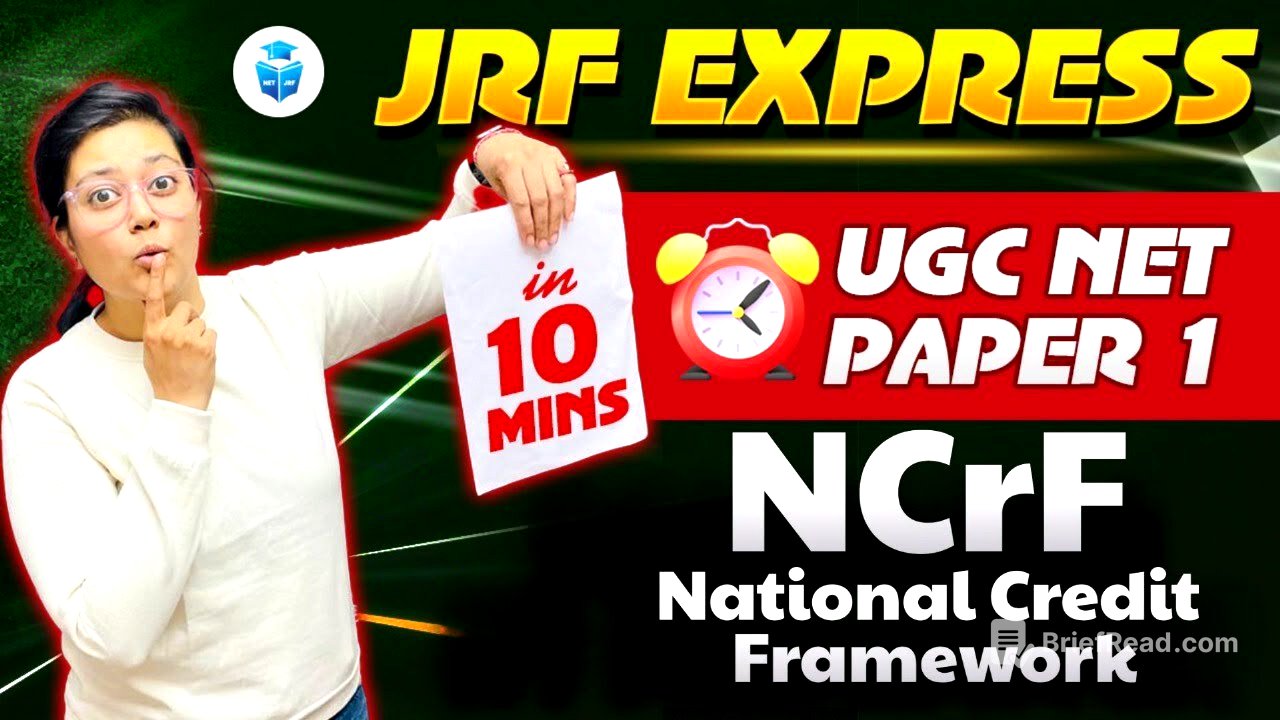TLDR;
This video explains the National Credit Framework (NCrF) and its alignment with the National Education Policy (NEP) 2020. It uses the example of "Ramesh," a skilled agricultural worker without formal education, to illustrate how the NCrF can recognize and credit non-traditional learning. The video covers the structure, benefits, and implementation of the NCrF, including credit accumulation, transfer, and redemption for further education and job opportunities.
- NCrF aims to remove barriers in the education sector and integrate skills with holistic education.
- Various educational bodies like UGC, AICTE, NCERT, and MOE have contributed to developing the NCrF.
- The framework includes the National Skills Qualification Framework (NSQF) and provides credits for all levels of education and skills.
Introduction: The Story of Ramesh and the National Credit Framework [0:53]
The video starts with the story of Ramesh, a skilled agricultural worker who lacks formal education, to highlight the need for recognizing skills and knowledge gained outside traditional schooling. Despite Ramesh's expertise, he is considered illiterate due to the absence of a degree or diploma. The narrator introduces the National Credit Framework (NCrF) as a solution to align with the New Education Policy 2020, enabling credit recognition for special learning and providing pathways for further education and skill recognition.
Understanding the National Credit Framework (NCrF) [1:57]
The National Credit Framework (NCrF) aligns with the National Education Policy (NEP) 2020 to remove barriers in the education sector. It addresses demographic divisions and promotes holistic education and skill integration, teaching aptitude, higher education, and research. The NCrF supports lifelong learning, aspirational education, and skilling initiatives. UGC, AICTE, NCERT, DOCL, MOE, MSDE, and DGT are responsible for its development.
Key Verticals and Benefits of the NCrF [4:13]
The NCrF has three main verticals: the National Skill Qualification Framework (NSQF), the National Higher Education Qualification Framework, and schooling. Credits are awarded for every degree, class, and skill, enabling the measurement of complete learning. This system increases accessibility across educational levels and provides flexibility through multiple entry and exit options, as emphasized in the new education policy. IITs, IIMs, NITs, and other institutions of national importance follow this credit system, which aids in admissions and further studies.
Inclusion, Creativity, and Credit Management [5:14]
The NCrF encourages creativity and makes diverse learning approachable, accommodating both gifted and progressive learners. Individuals like Ramesh can receive recognition and credit scores for diplomas in agriculture, facilitating their advancement. Credit management involves assignment, storage, transfer, and redemption, enabling job applications through certificates in the skill-based era. One year of education learning equals 1200 national learning hours, resulting in 40 credits, with one credit equivalent to 30 learning hours.
Credit Calculation and Shift to Skill-Based Education [6:37]
The discussion covers how credits are awarded and how the system shifts from traditional to skill-based education, incorporating classroom, experimental, and exploratory learning. Different credits are given across school, higher, vocational, and skill education. The narrator emphasizes the importance of understanding the credit system, noting that questions about NCrF are likely to appear in exams.
Credit Levels and Important Notes [7:30]
The video provides a detailed table showing credit levels for various degrees and classes, from primary education to PhD. A PhD earns 8.0 credits under the National Skill Qualification Framework, with 40 credits earned per year, totaling 320 credit points. The narrator explains how to calculate total credit points earned by a student by multiplying the NCrF level by the credits earned at that level. The Academic Bank of Credit (ABC) expands these credits to include school education, vocational training, skills, internships, and projects, aiding in admissions and certifications.
Conclusion and Homework Question [9:55]
The narrator concludes by reiterating the importance of the National Credit Framework and provides a homework question to reinforce understanding. The PDF of the presentation will be available on the JRF Adda application, along with tests every Thursday and Sunday. The narrator also promotes a countdown series on JRF Adda, offering live question-solving sessions for research, ICT, and logical reasoning.






![Roller Coaster the Series EP 5 [2/4] Loft eats Pure again 😋😋 รัก ขบวนนี้หัวใจเกือบวาย | EP.5](https://wm-img.halpindev.com/p-briefread_c-10_b-10/urlb/aHR0cDovL2ltZy55b3V0dWJlLmNvbS92aS9XMmVkWW8tbi1oQS9ocWRlZmF1bHQuanBn.jpg)


